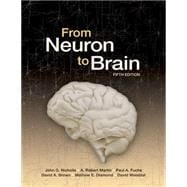From Neuron to Brain, Fifth Edition, provides a readable, up-to-date book for use in undergraduate, graduate, and medical school courses in neuroscience. As in previous editions, the emphasis is on experiments made by electrical recordings, molecular and cellular biological techniques, and behavioral studies on the nervous system, from simple reflexes to cognitive functions. Lines of research are followed from the inception of an idea to new findings being made in laboratories and clinics today.
A major change is that this edition begins with the anatomy and physiology of the visual system, from light receptors in the retina to the perception of images. This allows the reader to appreciate right away how nerve cells act as the building blocks for perception. Detailed mechanisms of signaling are then described in later chapters. All chapters have been rewritten, and new chapters added.
From Neuron to Brain will be of interest to anyone, with or without a specialized background in biological sciences, who is curious about the workings of the nervous system.
RESOURCES
The From Neuron to Brain Instructor's Resource Library includes all of the figures (including photographs) and tables from the textbook, sized and color adjusted for optimal legibility when projected.








